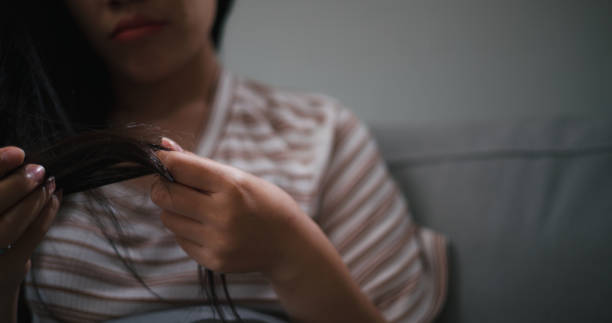
Life can be a journey filled with ups and downs; for some, these struggles manifest in ways that are not immediately visible to the outside world. Trichotillomania, often referred to as “Trich,” is a hidden battle that affects millions of people worldwide. Trichotillomania is defined as a compulsive desire to pull one’s hair. This can include body hair, eyelashes, eyebrows, and/or head hair.
For some, hair-pulling is focused. It is done on purpose to relieve stress and can include ritualization. Ritualization is common in disorders like Trich; a ritual is a set of behaviors surrounding an action or event. They may be physical actions or specific thoughts, such as tapping surfaces several times or counting in one’s head. They may involve very specific locations and objects in order to complete. For others, hair-pulling is automatic, occurring without the person being aware of it (such as while watching television or when bored. It is referred to as Body-Focused Repetitive Behavior (BFRB), much like dermatillomania (or skin-picking). Let’s explore the truth about Trichotillomania and its nature, causes, and effective therapy strategies for managing and overcoming this challenging disorder.
3 Hidden Secrets About Trichotillomania

1) It’s more common than you think: An estimated 2-4% of the population will experience Trichotillomania at some point in their lives. Despite its prevalence, many individuals with Trich suffer in silence due to shame and embarrassment.
2) There is a profound emotional impact: Hair loss can lead to feelings of shame, embarrassment, and low self-esteem, which, in turn, can worsen the urge to pull.
3) Trichotillomania involves habit and ritual: The repetitive nature of this habit can provide a temporary sense of relief or comfort, even though it often leads to physical and emotional distress.
5 Ways to Overcome Trichotillomania
1) Cognitive Behavioral Therapy:

In Cognitive Behavioral Therapy (CBT), individuals work with a therapist to identify and change the thoughts, emotions, and behaviors associated with hair pulling. We use CBT for trichotillomania treatment in Woodland Hills.
This treatment utilizes the key components of CBT:
Awareness building, wherein the person begins to take note of when a behavior is occurring in real-time and upon reflection. They can feel changes in their body and mood as they become triggered and are conscious that they are experiencing sensations that usually precede the behavior (in this case, hair-pulling).
Stimulus control, wherein the presence or absence of a specific stimulus impacts behavior, can be utilized to either subvert the impulse to hair-pull or as a list of what to avoid to avoid the impulse to hair-pull. You may train yourself to pick up an item that keeps your hands busy when you experience certain stimuli, for example. Or you may avoid specific locations or activities because they stimulate your urge to pull your hair.
Cognitive restructuring allows us to reframe our thought process. For example, we meet a negative thought, such as, “I’m going to fail,” with a positive one: “I can do it if I try!” We restructure not only by combating our negative thoughts directly but also by questioning them. We might ask ourselves, “Why do I think that will happen?” or, “Where is the evidence of that?”
Response prevention is beneficial in cases where stimuli cannot be controlled. Exposure and Response Prevention Therapy (ERP) reduces the impact of triggers. ERP utilizes gradual exposure to triggers over time, sometimes beginning with guided visualization in a neutral environment until the person is able to confront their trigger without becoming triggered themselves.
Relapse prevention is key in any therapeutic treatment because no recovery is a straight line. Backslides, missteps, and relapse are to be expected. When you prepare for relapse, you can work to prevent it. Relapse prevention encourages a focus on staying in a state of abstinence from the behavior and also aims to prevent any behavior lapse that might occur from becoming a full-blown relapse of behaviors, emotions, and triggers.
2) Awareness Training:

Identifying when and where hair pulling occurs is the first step in ceasing the action. For those who hair-pull automatically, stopping to take stock of the instances can lead to new discoveries. Some people pull their hair while watching some form of entertainment, when bored (perhaps in a class or a meeting at work), or when reading. Becoming aware that the behavior is occurring may take practice or assistance from those around you. While you may not always realize you are hair-pulling while it’s happening, you can become accustomed to the situations in which the behavior is more likely to occur. When entering those situations, you can then be prepared to be vigilant and have replacement behaviors at the ready.
For those people who are more likely to hair-pull intentionally, the awareness comes in identifying triggers. Are there certain environments, events, interactions, times of year, or some other pattern that can be identified? Do you know when this behavior began for you; do you always remember pulling out your hair all the way back through childhood?
Through awareness training, you are not only taking note of when you are engaging in behaviors but also how you are feeling beforehand. Noticing these situations is important, but so is having an understanding of your physical, mental, and emotional state before the behavior starts. “I had a fight with my partner” is a straightforward observation. It is also beneficial to identify where you were experiencing tension in your body at the time if you were in any sort of pain, what emotions were coming to the surface, and how clear your thoughts were. Once you can take stock of those cues, you can determine if and when you experience them in other scenarios.
3) Mindfulness and Relaxation Techniques:

Mindfulness practices, such as meditation and deep breathing exercises, can help individuals with Trichotillomania become more aware of their urges and develop greater self-control. These techniques can be particularly useful in managing overall stress and anxiety, which often exacerbate hair-pulling behaviors. When stress and anxiety are lower in general, the threshold for withstanding triggers is higher. A greater sense of general well-being can do wonders for working on urge-based behavior disorders.
Meditation often involves taking time to be still and quiet, focusing on your breathing, and observing thoughts and feelings as they arise. The aim of these observations is that they are as neutral as possible; it is not about judging the thoughts or assigning them moral value.
There is more than one way to meditate. Most people picture it as sitting crisscross, alone in a quiet room, and trying not to think about anything. While sitting or lying down quietly is a beneficial practice, it is not the only one. Some folks prefer to meditate by going for a walk. If you have trouble sitting still, active meditation may be the thing for you. Instead of solely focusing on your breath, you may focus on how your body feels as it moves, how your feet feel when they make contact with the ground, how your arms swing, and so on.
Mindfulness is about living in the present moment. The observations you make in real time allow you to be grounded in what is happening right now, rather than worrying about what may happen or ruminating about something that has already happened and cannot be changed. Bringing your awareness to your body (such as noticing your breath or doing a body scan for tension) can help you to remain rooted where you are. You can also use sensory cues, such as what you can see, smell, taste, feel, and/or hear. It might work for you to choose one sense, perhaps the one you are most aware of, and work your way through the rest. Or you may want to think about which sense you are least aware of and try to heighten that sense through focus and concentration. Do you hear traffic? Birds? Can you feel the texture of your clothing, the smoothness of your steering wheel, and the cold surface of your desk? What do you smell? A colleague’s fragrance, your cup of coffee? How many blue items can you see? Are they similar shapes and sizes? Do you taste anything? Do you have gum or a beverage handy that you can utilize? Our senses are powerful when we focus on them.
4) Support Groups:

Sharing experiences and coping strategies with others who face similar challenges can reduce feelings of isolation and provide encouragement. The people we see here for trichotillomania therapy in Woodland Hills report that having a place to go where they can relate to others helps them feel less alone and, therefore, reduces their shame. A sense of community is a great way to combat feelings of loneliness, being misunderstood, and being stigmatized. No matter how well-meaning people in your life may be, they won’t truly relate to what you are going through with Trich unless they also struggle with it. Their support and love can be a great resource for helping you to feel good, but a support group is the best place for you to feel truly understood.
You might worry that it will be difficult to find a group for such a specific mental health disorder. Because there is compulsion and obsession involved with Trich, it falls under the classification of Obsessive Compulsive Disorder (OCD). OCD groups may offer support and insight even if they are not specifically supposed to be spaces for people who have Trich. Due to the nature of hair-pulling and the physical outcomes, Trich can be considered a lesser-known subtype of OCD known as Harm OCD. Whether or not your conscious intention in hair-pulling is to self-harm, there is a component of it due to the pain that can be experienced during the behavior and the emotional ramifications of seeing missing patches of hair, etc.
There are various ways to connect with support groups. Some meet in-person, some video call, or have message boards. Hopefully, you are able to find a group that meets in the modality and with the frequency that works best for you. It is important that you find a group where you feel safe. How much you share and how many members of your group is ultimately up to you. With the reach of the internet, the odds are good that you will at least be able to find solace online if you aren’t able to find a group that works for you nearby.
5) Medication:

In some cases, healthcare providers may prescribe medication to help manage the symptoms of Trichotillomania, especially when it co-occurs with conditions like anxiety or depression. Medications that are prescribed for mental health disorders are not a cure-all; they are used in combination with therapy. If you are able to find a medication that is the right fit for you, it can help to reduce or eliminate some of your symptoms, thereby making it easier to navigate your day-to-day life.
The medications that are most commonly effective for Trichotillomania are SSRIs (Selective Serotonin Reuptake Inhibitors) and Clomipramine (which is an antidepressant used to treat people who have OCD). Serotonin is a neurotransmitter, which means that it carries signals between cells in the brain. Typically, serotonin is reabsorbed by nerves after the signal has been delivered; an SSRI prevents that re-absorption (the “reuptake”), thereby leaving more serotonin available for transmitting messages among cells. This increased level of serotonin in the brain helps to elevate mood and relieve anxiety.
Different variations on these medications may require different frequencies of dosage or that the medication be taken in certain circumstances as relating to food or other medications. Which medication works best for you will depend on a variety of factors and a medical professional should be involved in the process of determining what works best. It can take a while to figure out. This trial-and-error period can be emotionally taxing, so having a therapist to help support you through it is a good idea.
Like most mental health disorders, there is both misinformation and a lack of information that can make Trichotillomania difficult to navigate. Staying in touch with your therapist and communicating your fears, your questions, your discoveries, and your goals is a great way to remain connected to your own personal experience. It is more beneficial to make slow progress that suits you than to pressure yourself to “fit” what you’ve seen elsewhere. There is no one tried-and-true way that will tell you how to cope with Trichotillomania. Being brave and willing to try new things, to return to CBT and its methods even after setbacks, is what will help you begin to feel better. As you progress through life and through your treatment, you may need to revisit your coping strategies, confront new triggers, and adopt new aversion behaviors. That is why it is important for you to know that you can always connect with someone who can provide you with care, insight, and support, but also that you know that you have the capability to adapt and continue your Trichotillomania treatment, no matter what setbacks may arise.
Trichotillomania Treatment in Woodland Hills
Are you confused and distressed by your uncontrollable urge, whether it’s pulling your hair (Trichotillomania)? Maybe it started as a child or intensified during young adulthood. Right now, you may feel embarrassed, ashamed, and alone in overcoming your urges to pull your hair. In our office in Woodland Hills, our OCD specialists understand that BFRBs, such as Trichotillomania, are part of the Obsessive-Compulsive Spectrum disorders and need individualized treatment that is more than just talk therapy. Contact us today for your complimentary 20-minute phone consultation with our Client Care Coordinator.




